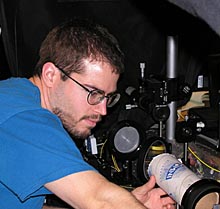December 4, 2006
Bachmann Fellowship supports graduate student's work on astronomical instumentation
By
Tim Stephens
Mark Ammons, a graduate student in astronomy and astrophysics,
has received a Bachmann graduate fellowship to support his research
at the Laboratory for Adaptive Optics.

Bachmann Fellow Mark Ammons works in the Laboratory
for Adaptive Optics.
Photo: T. Stephens |
The fellowship is funded by the Henry Bachmann Endowed Chair for Astronomical
Instrumentation, established in 2000 with a gift from Donald C. and Sally Allen
in honor of Sally Allen's grandfather, Henry Bachmann, who was an instrument
maker at Lick Observatory in the early 20th century.
Michael Bolte, as director of UC Observatories/Lick Observatory (UCO/Lick),
holds the Bachmann Chair and selected Ammons to receive the fellowship.
"UC Santa Cruz is one of only a few institutions in the U.S. where
students can get hands-on training in forefront astronomical instrumentation,"
Bolte said. "The Bachmann Fellowship is wonderful for helping to attract
the very best young instrumentalists to Santa Cruz for their studies."
Ammons is currently working on several projects, including adaptive
optics instrumentation for extremely large telescopes. Adaptive optics
(AO) sharpens the vision of ground-based telescopes by counteracting
the blurring effects of turbulence in the Earth's atmosphere. UC is
one of three partners currently designing a 30-meter telescope that
will be equipped with an advanced AO system. It will have a view of
the heavens that is more than 10 times sharper than that of the Hubble
Space Telescope, Bolte said.
"In the Laboratory for Adaptive Optics, we have a mockup of a 30-meter
telescope that has been scaled down to fit in the lab, and we have been
testing different adaptive optics techniques for future telescopes," Ammons
said.
Current AO systems use a single point-source of light -- either a bright
star or an "artificial guide star" created by a laser -- as a reference
for measuring atmospheric blurring. The system then calculates the corrections
needed to counteract that distortion and applies the corrections by bouncing
the light gathered by the telescope off a deformable mirror. This process
is repeated hundreds of times per second to keep up with the constantly
changing distortions caused by atmospheric turbulence. With the systems
now in use, the correction is only applied over a small area of the sky.
Ammons is working on a project to develop advanced AO technology for
the giant telescopes of the future using an approach called "multiconjugate" AO.
The goal is to extend the corrections over a wide field of view by using multiple
laser guide stars. This technique will be needed for the giant telescopes now
in the planning stages.
Ammons also plans to use adaptive optics on existing telescopes to
address questions regarding star formation and the buildup of galaxies
in the early universe. His adviser is Claire Max, professor of astronomy
and astrophysics, director of the Center for Adaptive Optics, and principal
investigator of the Laboratory for Adaptive Optics.
The first Bachmann Graduate Fellow was Andrew Sheinis, who worked on
instruments for the Keck Observatory under the guidance of Joseph Miller,
professor of astronomy and astrophysics and former director of UCO/Lick.
Sheinis is now a faculty member leading the instrumentation program at the
University of Wisconsin.